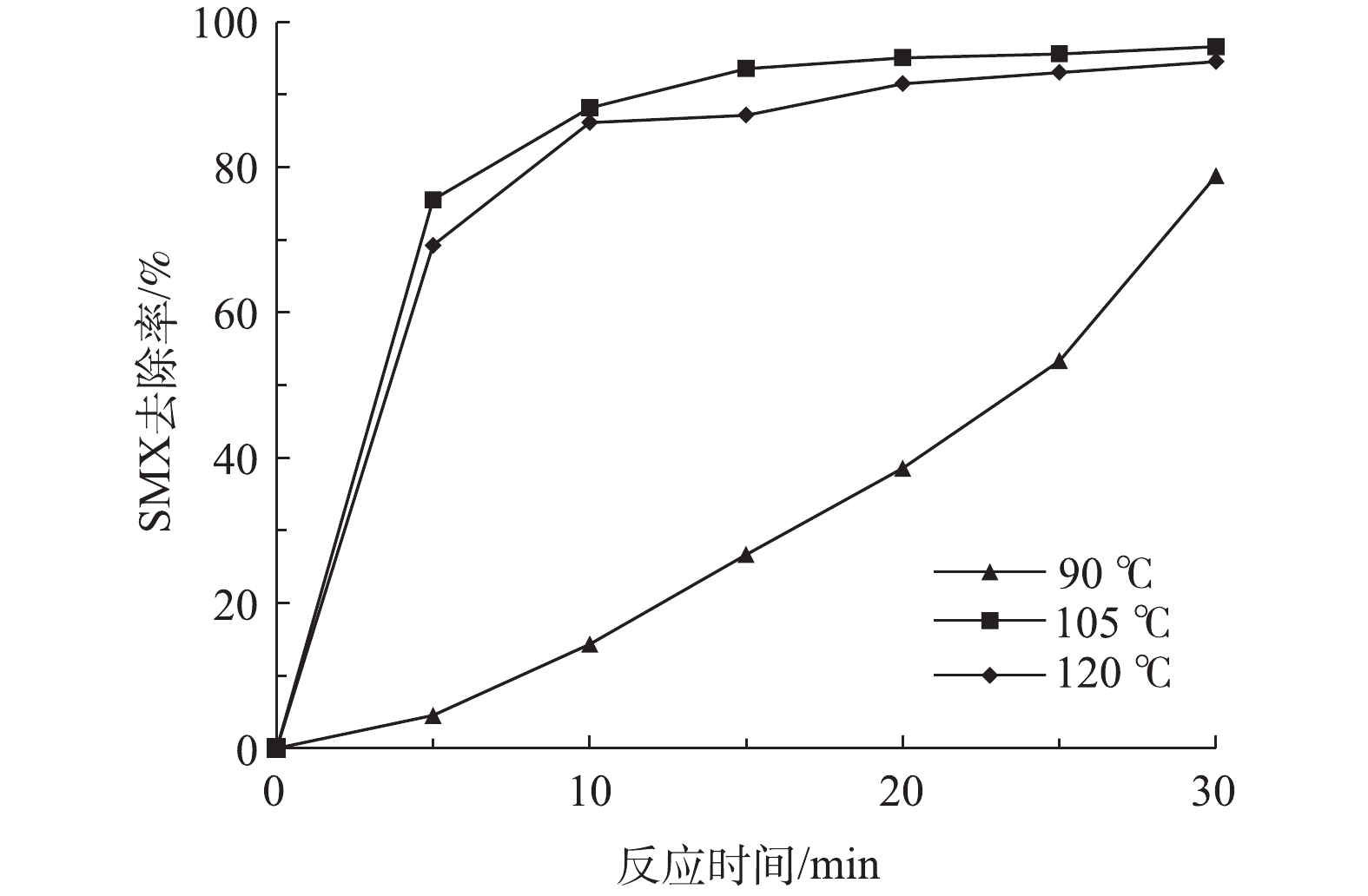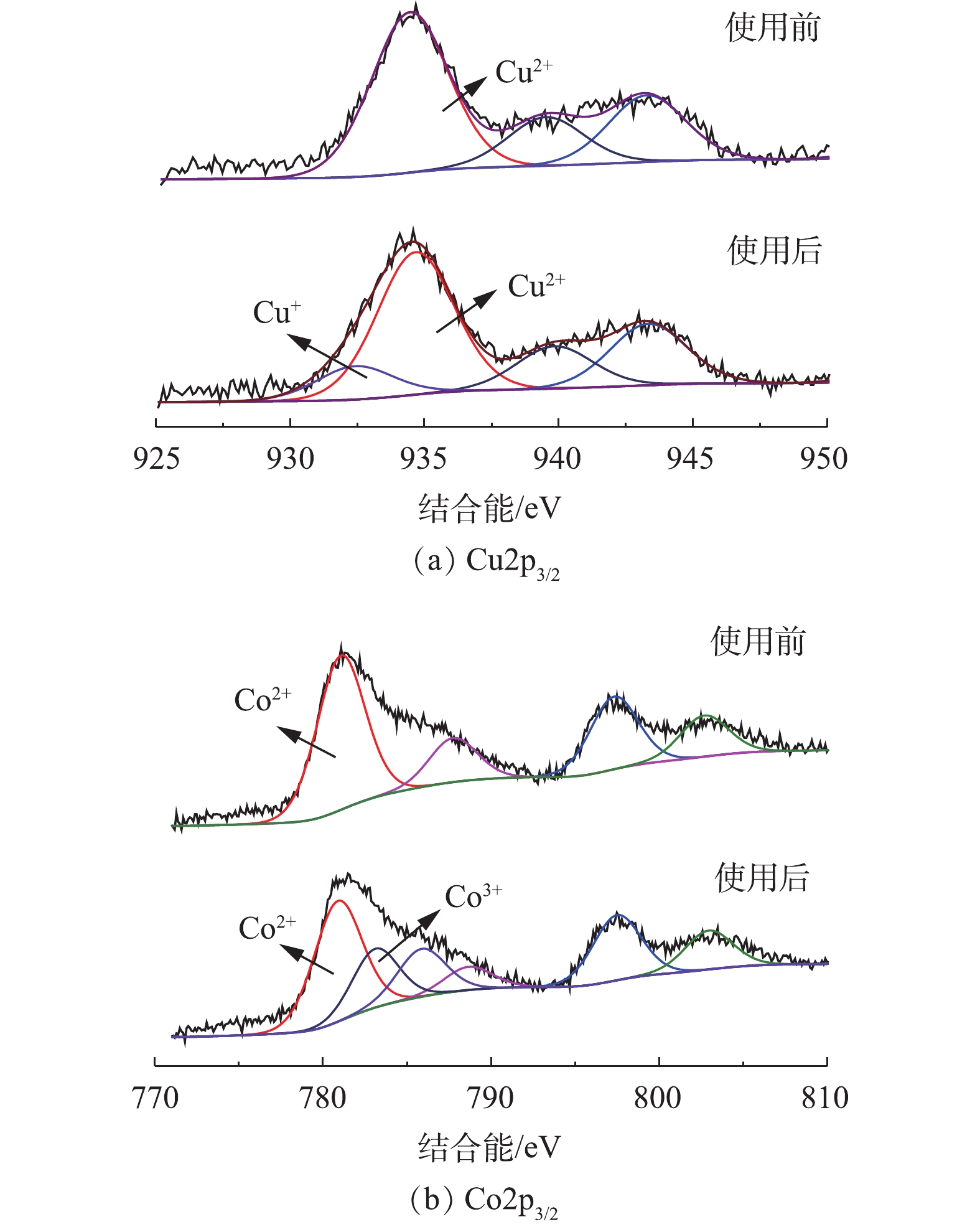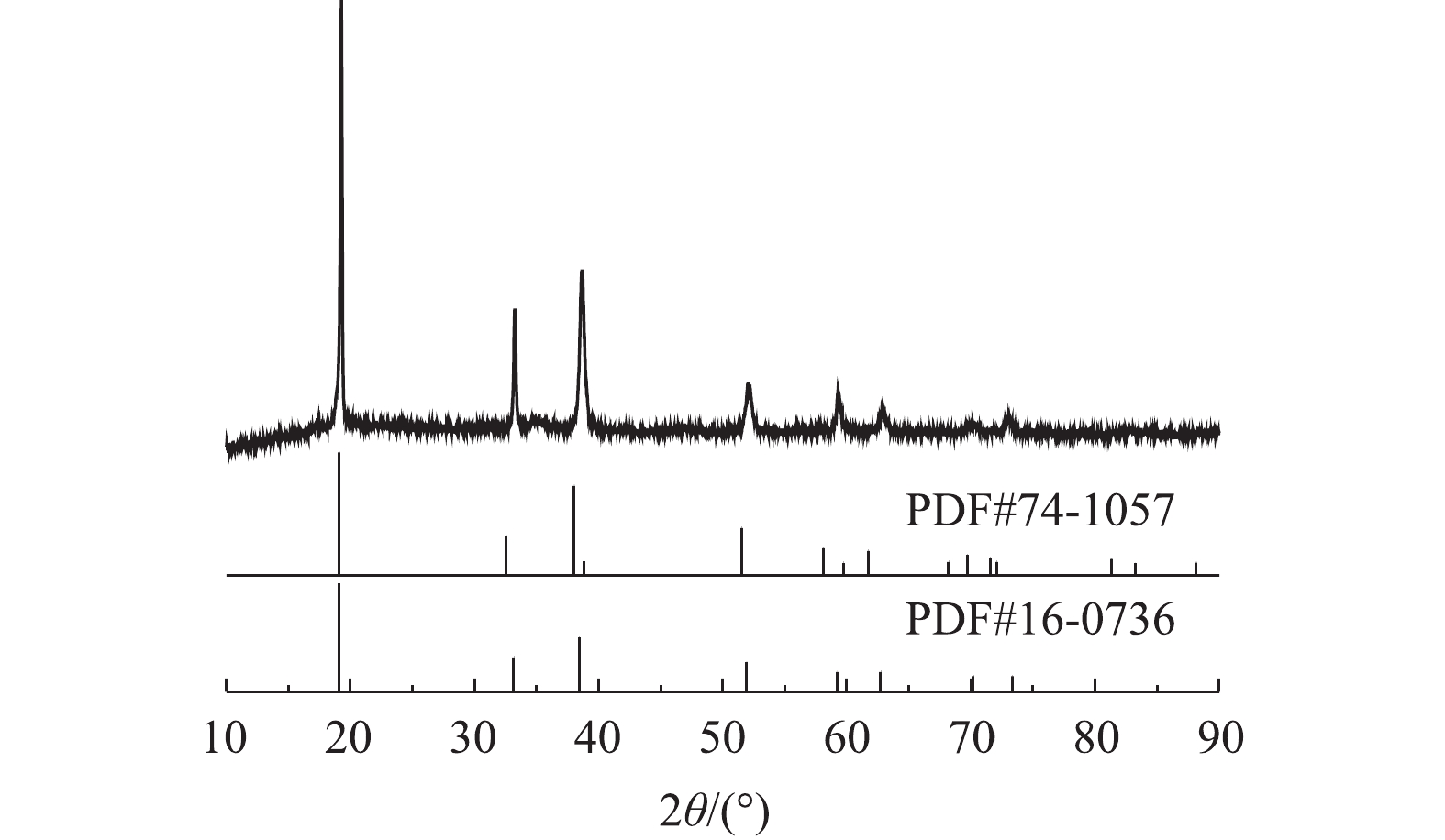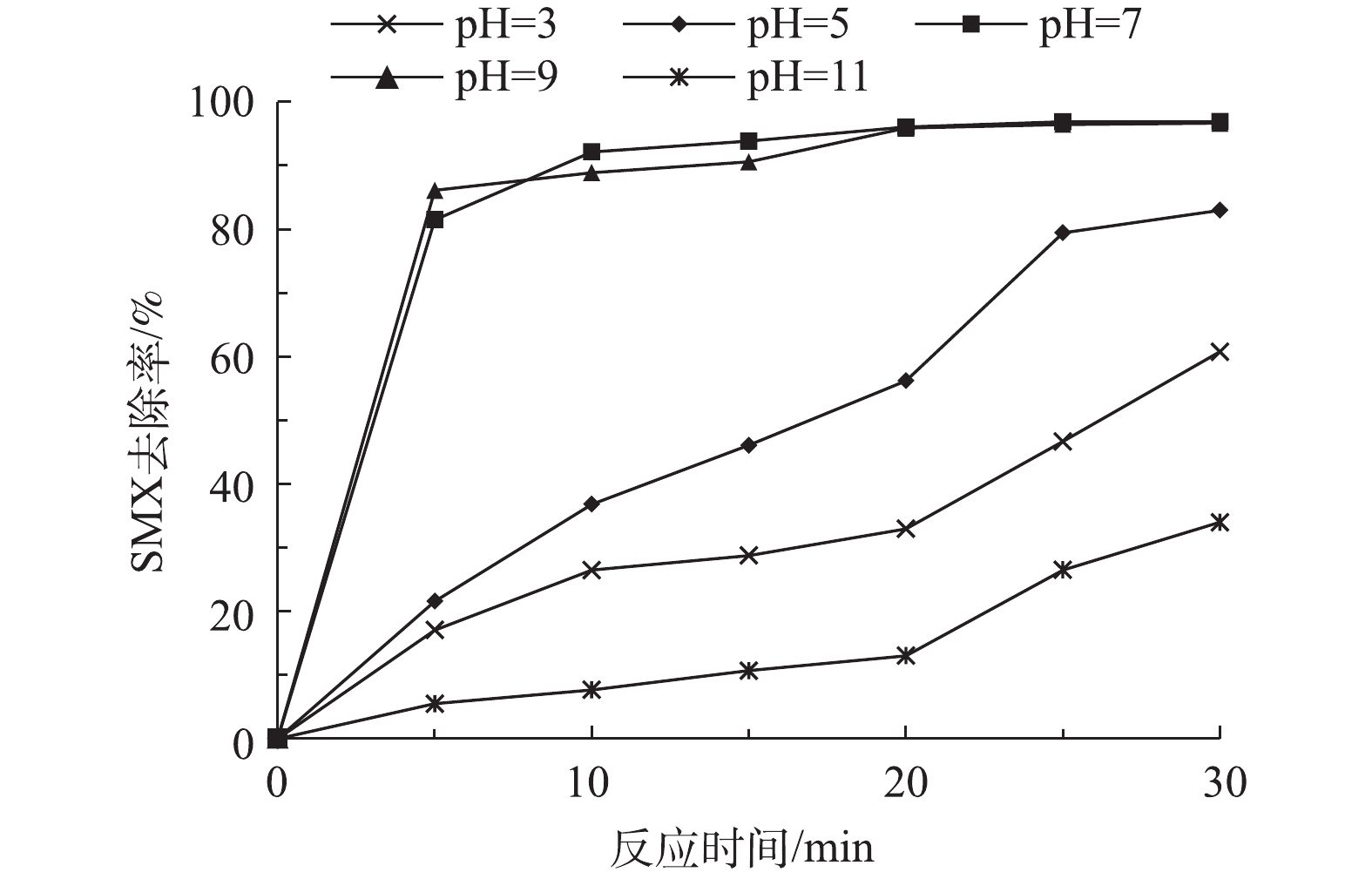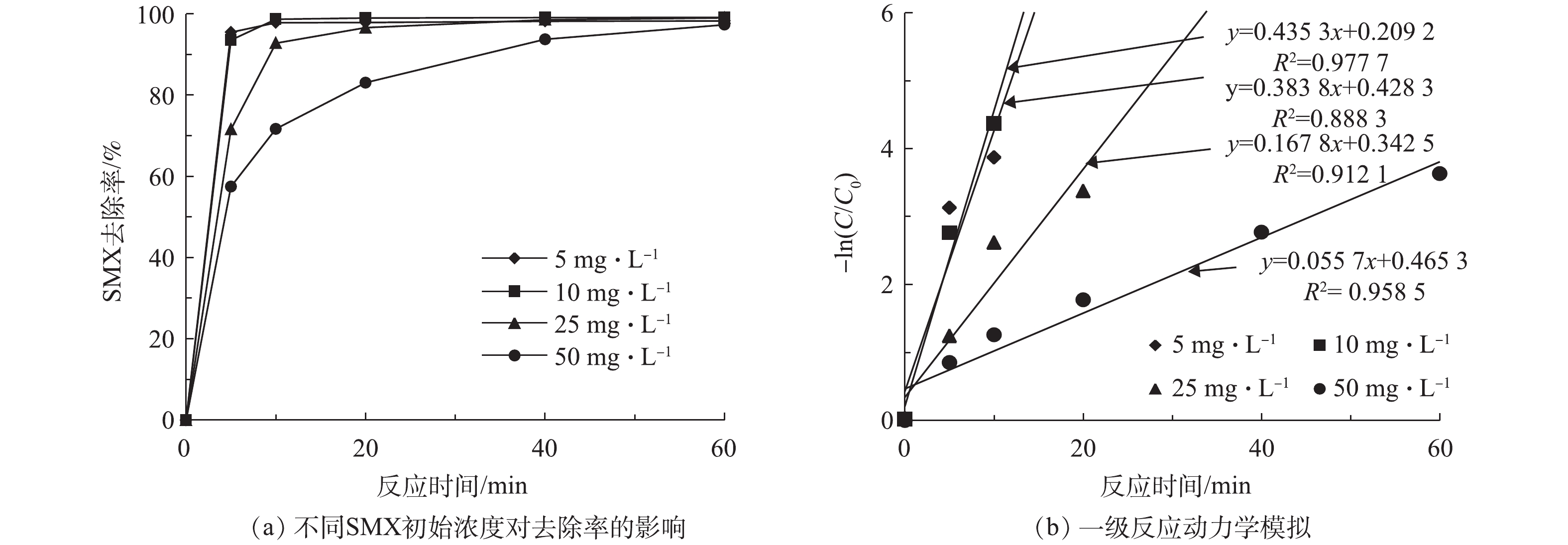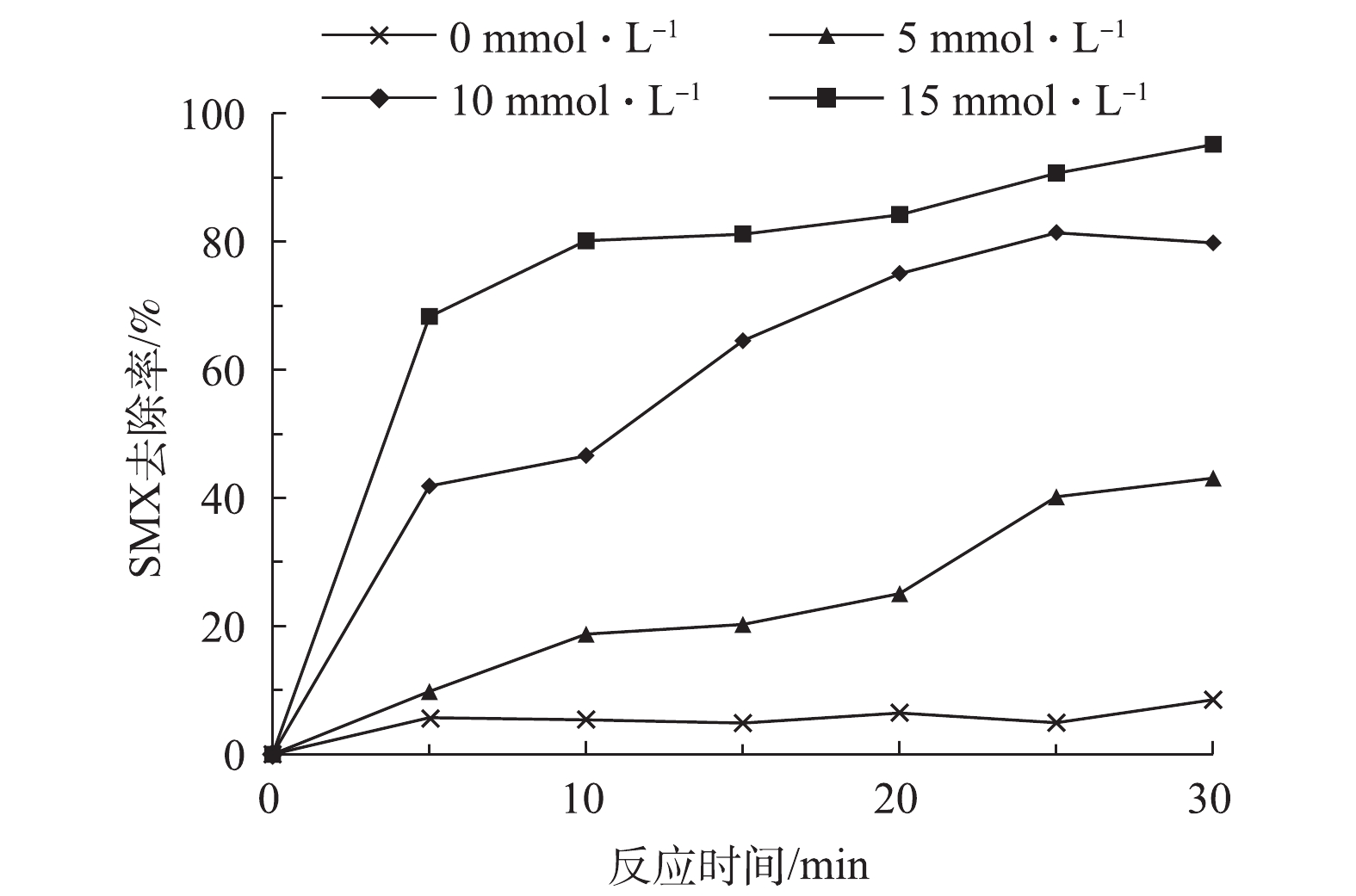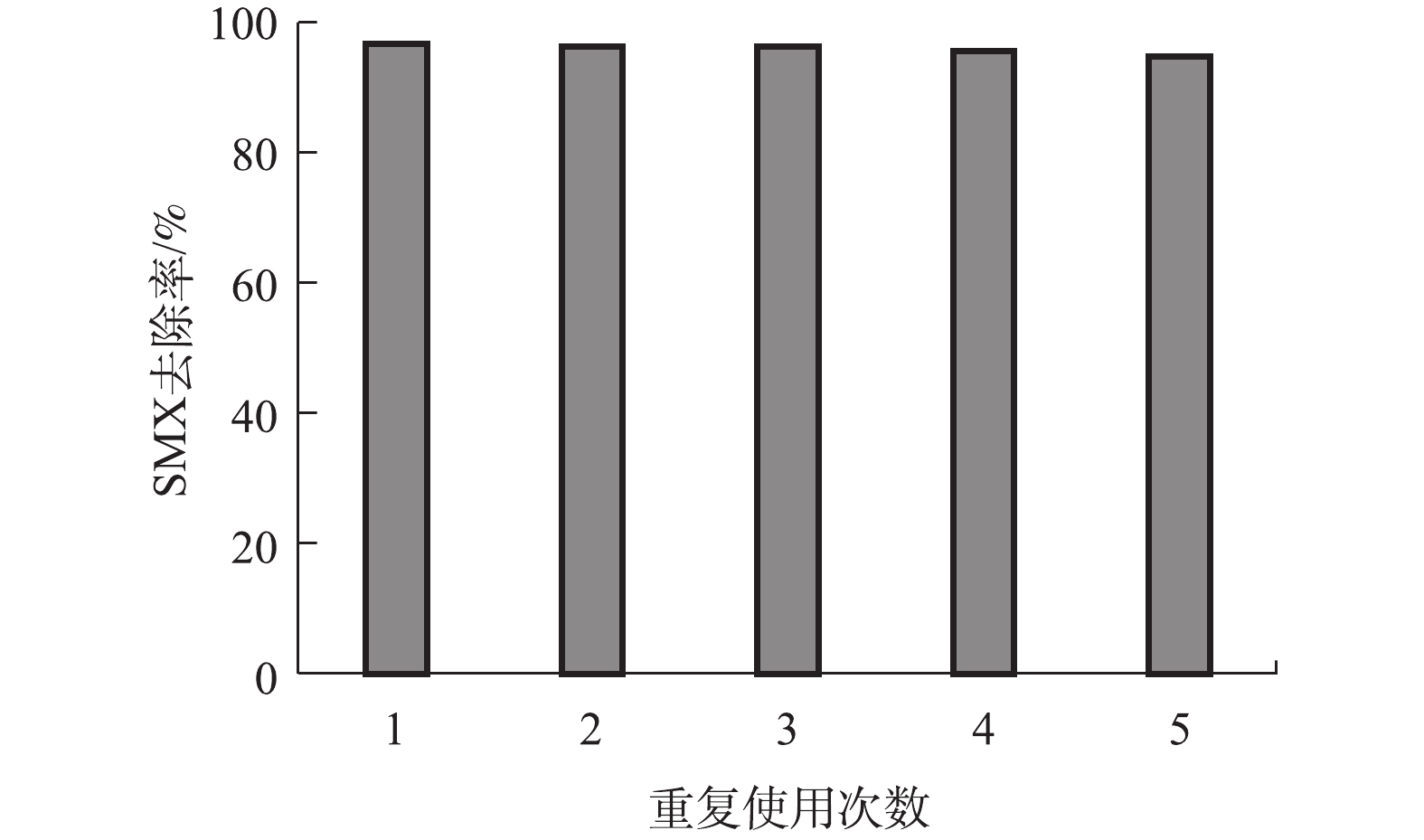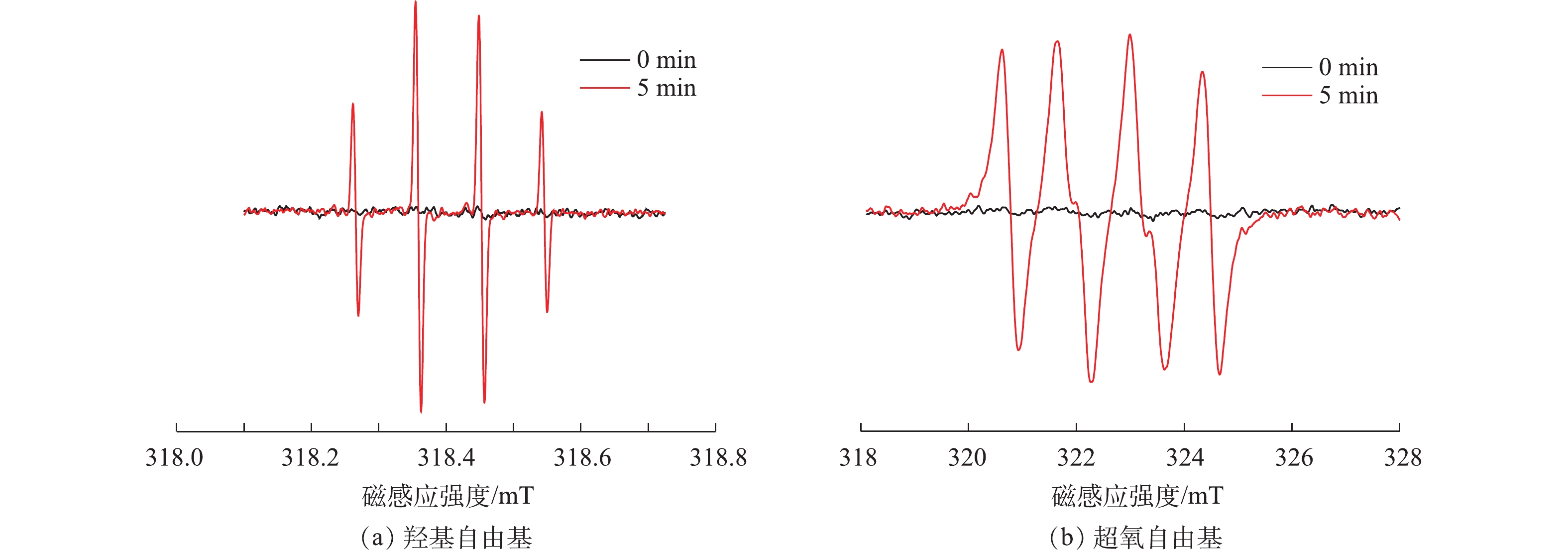-
磺胺甲恶唑(sulfamethoxazole, SMX)作为一种广谱抗生素,由于其价格低廉、性质稳定、抗菌谱广等优点而被广泛应用于医疗、养殖等行业[1-2]。然而,SMX在环境中不易被降解,传统的城市污水处理厂对SMX的去除率仅为20%~30%[3],这使得其在城市污水处理厂的出水中可检测出较高的浓度[4-5]。此外,对我国自然水体中158种药品与护理品污染物(PPCPs)的监测结果表明,SMX是检出率最高的污染物[6]。环境中的SMX不仅对植物生长具有不利影响,也可对人体健康造成危害[7-8]。因此,需要研究高效的高级氧化方法以强化SMX去除。
非均相类芬顿催化氧化技术因其具有适用pH范围宽、催化剂可循环使用、二次污染少等优点近年来备受关注[9-10]。目前,研究的非均相类芬顿催化剂种类较多,Cu、Mn、Co、Ti、Ni等金属均可用于合成非均相类芬顿催化剂,在处理难降解有机物污染物的过程中表现出较好的氧化分解能力[10]。如采用膜分散法通过耦合沉淀反应合成的Cu2O催化剂,在其投加量为0.5 g·L−1、30%的H2O2投加量约49 mg·L−1时,4 min内可使15 mg·L−1罗丹明B脱色率达到100%[11]。水热法合成的γ-MnO2可在投加量为0.1 g·L−1、H2O2浓度为49.3 mg·L−1条件下,20 min内实现罗丹明B的完全脱色[12]。为了提高非均相催化剂的性能,常利用多种不同价态和氧化还原能力的金属离子,制备合成新型的类芬顿催化剂。如固定在有序介孔Si上的Fe-Cu双金属催化剂,在其投加量为1 g·L−1、2 000 mg·L−1 H2O2和中性pH条件下,30 mg·L−1氧氟沙星360 min的去除率达70%以上[13]。采用溶胶凝胶法合成的LaFeO3催化剂,在其投加量为1.4 g·L−1、782 mg·L−1 H2O2和pH=7.14条件下,3 mg·L−1的SMX 120 min的去除率达90%[14]。目前,利用非均相类芬顿反应降解SMX的研究虽有所报道[14-15],但仍需要合成具有高催化活性、强稳定性及易分离回收的类芬顿催化剂,以实现对SMX的高效去除。
本研究采用原位溶剂热生长法合成了Cu-Co非均相类芬顿催化剂,采用SEM、XRD等方法对催化剂的结构和形态进行了表征,探讨了不同反应条件对SMX降解率的影响,分析了Cu-Co双金属氢氧化物(CuCo-BH)非均相类芬顿催化剂的催化机制,以期为实际废水中SMX的类芬顿催化降解提供理论基础。
全文HTML
-
将0.29 g Co(NO3)2·6H2O、0.241 6 g Cu(NO3)2·3H2O、0.463 g NH4F和3.003 g CO(NH2)2溶解于30 mL去离子水中,搅拌30 min后定容到100 mL,即为生长液。催化剂的载体是4 cm× 4 cm,3 mm厚的碳毡,预处理方法为:浓硝酸浸泡30 min,然后用去离子水清洗干净,并在去离子水中浸泡超声15 min,再用丙酮浸泡超声15 min,乙醇浸泡超声15 min,最后用去离子水浸泡超声15 min。将预处理好的碳毡放入盛有100 mL生长液的聚四氟乙烯反应釜中,105 ℃下反应5 h,冷却后取出,用去离子水温和清洗后自然晾干,即制备出负载有CuCo-BH非均相类芬顿催化剂的碳毡。预实验结果表明,水热反应时间小于5 h时,催化效果较差,当水热反应时间为3 h时,在相同条件下,催化剂的性能仅为5 h时的80%;而当水热反应时间大于5 h后,催化效果没有明显提高。Co(NO3)2·6H2O、Cu(NO3)2·3H2O、NH4F和CO(NH2)2均为分析纯,购置于广州化学试剂厂。
-
在室温条件下,往150 mL烧杯中加入50 mL初始浓度为3 mg·L−1的SMX溶液,将负载CuCo-BH 催化剂的碳毡浸没在溶液中,加入一定浓度的H2O2,反应开始后,每隔一定时间进行取样,水样经0.22 μm滤膜过滤后,测定SMX浓度,最后计算SMX的降解率。
-
1) CuCo-BH催化剂的表征。利用扫描电子显微镜(Hitachi Su8010,Hitachi)、透射电子显微镜(TEM,Tecnai G2 20,美国FEI公司)对催化剂的形貌结构、负载情况等进行分析;采用X射线衍射(X Pert’3 Powder,荷兰帕纳科)与XPS(Scientific K-Alpha,美国ThermoFischer)对催化剂的物相及金属的价态进行分析。
2)自由基分析。采用电子顺磁共振波谱仪(electron paramagnetic resonance spectrometer,ESR,JES FA200,日本电子JEOL)对非均相类芬顿过程所产生的自由基类型进行分析,采用DMPO (5,5-二甲基-1-吡咯啉-N-氧化物)作为捕获剂;通过投加异丙醇、对苯醌等自由基淬灭剂,研究SMX降解过程中·OH和
O⋅−2 对SMX降解的贡献。3) SMX浓度测定。采用高效液相色谱法(P230II,大连依利特分析仪器公司)测定SMX浓度,色谱柱为SinoChrom ODS-BPC18 (250 mm×4.6 mm×5 μm),流速为1.0 mL·min−1,紫外检测器波长265 nm,柱温30 ℃,流动相为0.1%甲酸溶液/乙腈= 70/30(体积比)。
4) SMX的去除率R按式(1)计算。
式中:R为SMX的去除率;C0为SMX的初始浓度,mg·L−1;Ct为t时刻的浓度,mg·L−1。
1.1. 催化剂的合成
1.2. SMX降解
1.3. 分析和计算方法
-
在不同生长温度下,负载于碳毡上的CuCo-BH催化剂的SEM表征结果如图1所示。由图1中可以看出,碳毡上的催化剂负载量受生长温度影响:在90 ℃时,碳毡上只有少量的催化剂颗粒成核,晶体生长受限(图1(b)),CuCo-BH催化剂负载量非常低;在105 ℃时,碳毡上生长的CuCo-BH催化剂明显增加,几乎完全覆盖碳毡纤维(图1(c));在120 ℃时,碳毡上生长的催化剂量与105 ℃时相比差异性不大(图1(d))。
在pH=7.0、H2O2=15 mmol·L−1、无投加其他电解质的反应条件下,不同生长温度下合成的催化剂对3 mg·L−1的SMX降解效果如图2所示。将90 ℃下合成的催化剂用于非均相类芬顿过程中,SMX的去除效果最差,30 min内SMX的去除率仅为78.8%;而对于在105 ℃下合成的催化剂,86.2%的SMX可在10 min内被去除,30 min的去除率达到96.7%;当生长温度进一步上升到120 ℃时,合成的催化剂对SMX的去除效果没有显著上升,与105 ℃下合成的催化剂相比,性能反而略有下降,30 min内SMX的去除率为94.6%。综合上述结果,确定105 ℃下合成的催化剂为最优,后续实验均采用105 ℃下合成的催化剂开展研究。
-
在105 ℃时,负载在碳毡上的催化剂的透射电镜分析结果如图3所示,生长在碳毡上的CuCo-BH催化剂呈棒状结构,宽度为40~115 nm,长度可达650 nm。CuCo-BH催化剂的棒状结构有利于提高催化剂的比表面积,促进催化反应的进行[16]。CuCo-BH催化剂的XPS分析结果如图4所示。在使用之前,催化剂在934.68 eV的结合能值对应于Cu2p3/2,这表明Cu是以Cu2+的价态存在[17];催化剂在781.06 eV和797.31 eV的结合能值分别对应于Co2p3/2和Co2p1/2,这表明Co是以Co2+的价态存在[18]。在反应之后,催化剂在932.42 eV的结合能值对应于Cu2p3/2,显示有Cu+的存在;催化剂在783.11 eV的结合能值对应于Co2p3/2,显示有Co3+的存在。CuCo-BH催化剂的XRD测定结果如图5所示,其衍射峰与JCPDS(No.74-1057)和JCPDS(No.16-0736)一致,分别对应Co(OH)2和Cu7(OH)10F4,表明该催化剂的主要成分是Cu和Co的氢氧化物,并存在少量CuF2杂质,合成样品衍射峰峰形尖锐,说明样品的结晶度良好。
-
反应体系的pH对于类芬顿催化剂的性能有较大影响,采用NaOH与H2SO4调节溶液pH,考察在CuCo-BH非均相类芬顿体系中,不同pH (3、5、7、9、11)对SMX降解效果的影响,反应条件为SMX=3 mg·L−1、H2O2=15 mmol·L−1、无投加其他电解质。此外,在不同pH反应结束后,未发现有明显的pH变化,反应后溶液pH在设定pH±0.3的范围内,基本保持稳定。由图6中可以看出,当pH=3时,30 min内SMX的去除率为60.7%;当pH=11时,30 min内SMX的去除率仅为33.9%;而当pH=7时,SMX在30 min内的去除率达到96.9%;当pH=9时,SMX的去除率略低于pH=7。这表明本研究合成的CuCo-BH类芬顿催化剂的最佳pH=7,从实际应用看,城市污水及大部分工业废水的pH一般在中性范围,因此,采用CuCo-BH催化剂可以在不进行调节pH的条件下进行非均相类芬顿反应,与传统的芬顿反应相比,有望节约大量调节pH的酸碱。在pH=7、H2O2浓度为15 mmol·L−1条件下,对3 mg·L−1的SMX进行30 min的催化降解实验,测定反应前后溶液TOC浓度。结果表明,TOC的去除率约为60%。这表明本研究所采用的催化剂及其反应体系能够有效降解SMX,并实现其矿化,这与文献采用Fe3O4/Co3O4催化剂对SMX进行30 min的降解实验所得到的矿化程度相接近[19]。
在pH=3的条件下,催化剂中金属溶出增加,导致催化剂中活性组分降低,从而使得固相催化剂性能下降;而在pH=11的条件下,H2O2易分解为H2O和O2,这也将导致催化反应生成的·OH和
O⋅−2 等氧化剂减少,使得SMX去除效果降低[20]。本实验结果与目前报道的含Cu双金属催化剂受pH的影响结果一致。ZHANG等[21]合成的Cu-Al催化剂,在pH=2的条件下,几乎对对硝基酚(4-NP)没有催化降解效果;在pH=10.0的条件下,60 min内对4-NP的降解率只有约60%;而在pH=6或7的条件下,60 min内对4-NP的降解率高达90%以上。GUO等[20]的研究表明,Co-Cu双金属催化剂在pH=6.8的条件下对蒽醌类物质的去除效果要远优于pH=4.2和pH=10.4。在pH=7.0、H2O2=50 mmol·L−1、无投加其他电解质的反应条件下,不同SMX初始浓度对类芬顿反应降解SMX的影响如图7(a)所示。在60 min内,SMX初始浓度即使从5 mg·L−1增加到50 mg·L−1,类芬顿反应对SMX的去除率均可达100%。当SMX浓度为5 mg·L−1时,在5 min内,其去除率即可达到95%;而当SMX初始浓度为25 mg·L−1时,其在5 min内的去除率降低为71%;当SMX的初始浓度为50 mg·L−1时,其在5 min内的去除率仅为57%。在催化剂催化H2O2产生自由基总量不变的情况下,随着SMX初始浓度提高,去除SMX所需的时间也会相应增加。如图7(b)所示,在不同SMX浓度下,其降解过程符合表观一级反应动力学,当SMX浓度为5 mg·L−1时,降解反应的表观速率常数最大,为0.435 min−1,随着SMX初始浓度增加至50 mg·L−1,表观反应速率常数由0.435 min−1降至0.055 min−1。MILH等[22]采用过硫酸盐高级氧化法去除SMX,100 mg·L−1的SMX可在80 min内被完全降解,其降解过程也符合一级反应动力学,反应速率常数为0.002 9 min−1,拟合相关性系数为R2=0.992 9,与本研究结果一致。MALESIC-ELEFTHERIADOU等[23]采用光催化氧化方法去除1 mg·L−1 SMX,结果表明,该降解过程遵循一级反应动力学,反应速率常数为0.015 min−1。由于实验条件的不同(pH、光照、温度等),难以仅仅从表观速率常数上比较催化剂的优劣,但文献报道的不同高级氧化方法表明,SMX催化降解符合一级反应动力学过程。
在SMX=3 mg·L−1、pH=7.0、无投加其他电解质的反应条件下,不同H2O2浓度对类芬顿反应降解SMX的影响结果如图8所示,在不加入H2O2时,SMX在30 min内去除率仅为8%,这可能是负载催化剂的碳毡对SMX的吸附作用引起的。随着H2O2浓度的增大,SMX的30 min去除率不断提高。当H2O2浓度为10 mmol·L−1和15 mmol·L−1时,30 min内SMX的去除率分别为79.8%和95.1%,这表明SMX的降解主要是由于类芬顿催化剂催化H2O2产生自由基引起的,H2O2浓度的增加导致更多自由基的生成,从而加速了SMX的降解。
在SMX=3 mg·L−1,H2O2=15 mmol·L−1的条件下,不同电解质溶液对类芬顿反应降解SMX的影响结果如图9所示,电解质为10 mmol·L−1的NaCl和Na2SO4时,SMX在30 min内的去除效果分别为91.9%和80.9%;而当电解质为Na2CO3时,30 min内SMX去除率仅为16.8%,这可能是采用10 mmol·L−1 Na2CO3溶液时,溶液pH可达到11.0,这使得SMX的去除率大大降低。此外,Na2CO3溶于水后,可生成大量的
HCO−3 和CO2−3 ,HCO−3 和CO2−3 对·OH有一定的淬灭作用,两者能够反应生成CO⋅−3 ,从而导致SMX去除率的下降[24],反应如式(2)~式(4)所示。在SMX=3 mg·L−1、H2O2=15 mmol·L−1、pH=7、反应时间为30 min的条件下,CuCo-BH类芬顿催化剂循环使用次数对SMX去除效果的影响结果如图10所示。经过5次重复类芬顿反应后,SMX去除率始终保持在94%以上。此外,在本研究中,在pH=7的条件下,反应前后未见有明显的金属催化剂溶出现象,这表明CuCo-BH类芬顿催化剂的稳定性能良好。
-
采用ESR对CuCo-BH催化剂在类芬顿过程中催化H2O2产生的自由基进行测定,结果如图11所示。在0 min时,没有检测出捕获剂DMPO捕获·OH和
O⋅−2 的特征峰,在5 min后测定出含有强度比为1∶2∶2∶1的4个光谱信号,可对应于DMPO-·OH加合物的特征峰[25] (图11(a));强度比为1∶1∶1∶1的4个光谱信号,可对应于DMPO-O⋅−2 加合物的特征峰[26]。这表明在CuCo-BH催化剂的催化反应中,产生了羟基自由基·OH和超氧自由基O⋅−2 。为了进一步明确·OH和O⋅−2 在SMX降解过程中的作用,采用异丙醇和对苯醌进行自由基的猝灭实验,反应条件为SMX=3 mg·L−1、H2O2=15 mmol·L−1、pH=7、无投加其他电解质,其中,异丙醇和对苯醌分别为有效的·OH淬灭剂和O⋅−2 淬灭剂[27],结果如图12所示。异丙醇作为·OH淬灭剂已经有较多的报道[27-28],有研究[28]表明,异丙醇与·OH的反应非常迅速,速率常数高达1.9×109 L·(mol·s)−1,因此,在添加异丙醇后,一旦溶液中生成·OH,即被异丙醇优先反应而消耗;当投加13 mmol·L−1的异丙醇时,对SMX的降解有明显的阻碍作用,5 min内SMX的去除率仅为31.4%,而对照实验(0 mmol·L−1异丙醇)的SMX去除率为68.3%;当投加130 mmol·L−1的异丙醇时,极大地阻碍了SMX的降解,30 min内SMX的去除率仅为43.6%。而当投加6 mmol·L−1和12 mmol·L−1的对苯醌时,对SMX的去除均无明显的阻碍作用,即使投加了12 mmol·L−1的对苯醌,30 min内SMX的去除率仍达到91.6%。这表明·OH对SMX的降解起到了关键的作用。上述结果表明,·OH是CuCo-BH类芬顿催化剂催化H2O2的主要产物。有研究[29-31]表明,过渡金属Cu和Co具有可变价态和优良的氧化还原活性,其可能的催化H2O2产生·OH,进而降解SMX,具体反应过程如式(5)~式(9)所示。
与其他高级氧化方法,如光催化、芬顿氧化等相比,使用本研究获得的CuCo-BH催化剂的非均相类芬顿过程对SMX的去除效果更好,在取得相同的SMX去除率的条件下,反应所需时间更短[23, 32]。未来可开展实际废水中SMX的非均相类芬顿去除实验,以明确CuCo-BH催化剂其在实际废水处理中的应用效果。
2.1. 不同生长温度对催化剂的形态和性能的影响分析
2.2. 105 ℃下合成的催化剂形貌及组成分析
2.3. 不同反应条件下催化剂对SMX的降解效果分析
2.4. 生成的自由基种类及其作用比较分析
-
1)在105 ℃生长温度下合成的催化剂为最优,碳毡上CuCo-BH催化剂负载量较好;TEM表征结果表明,生长在碳毡上的CuCo-BH催化剂呈棒状结构,宽度为40~115 nm,最大长度可达650 nm。XPS表征结果表明,催化剂的价态以Cu2+和Co2+为主。
2) CuCo-BH催化剂的最佳使用pH=7,在SMX=3 mg·L−1、H2O2=15 mmol·L−1条件下,SMX在30 min内的去除率达到96.9%。SMX的降解主要是由于类芬顿催化剂催化H2O2产生的羟基自由基引起的,随着H2O2浓度逐渐增加,SMX的去除率有所升高。当电解质溶液为10 mmol·L−1的NaCl和Na2SO4时,对SMX的去除率影响不大,但电解质溶液为10 mmol·L−1的Na2CO3溶液时,SMX去除率显著降低。
3) ESR对自由基的测定结果表明,CuCo-BH催化剂催化H2O2的反应中产生了·OH和
O⋅−2 ;自由基猝灭实验结果表明,·OH对SMX的降解起到了关键的作用。





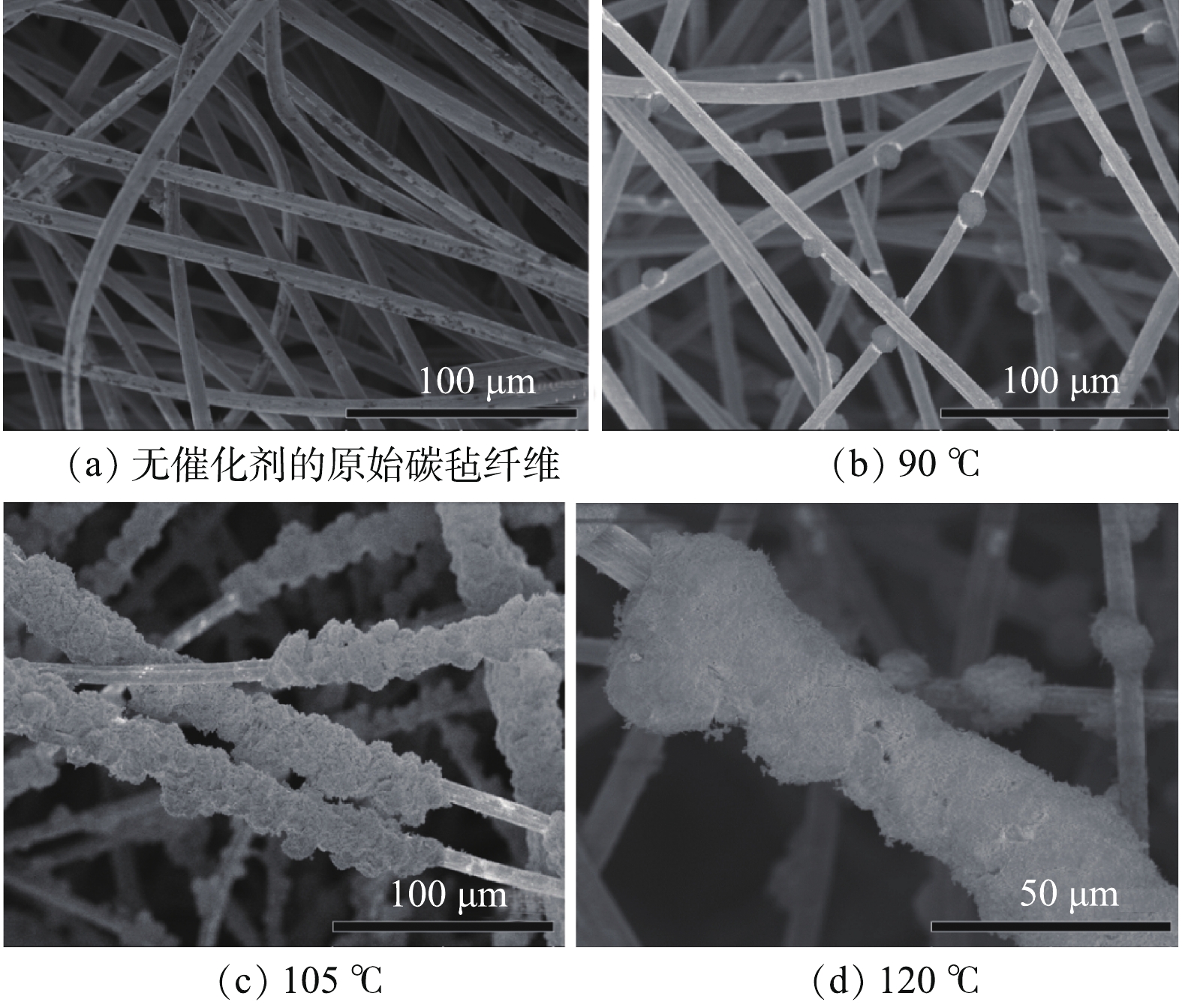
 下载:
下载:
